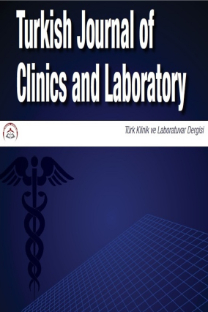Toraks cerrahisinde postoperatif analjezi yönetimi: iki yıllık deneyimlerimiz
toraks cerrahisi, postoperatif ağrı, hasta kontrollü analjezi yönetimi
Postoperative analgesia management in thoracic surgery: our two-year experience
toraks cerrahisi postoperatif ağrı, hasta kontrollü analjezi yönetimi, postoperatif ağrıhasta kontrollü analjezi yönetimi,
___
- 1. Marshall K, McLaughlin K. Pain Management in Thoracic Surgery. Thorac Surg Clin. 2020; 30: 339-46
- 2. Liu X, Song T, Xu HY, Chen X, Yin P, Zhang et al. The serratus anterior plane block for analgesia after thoracic surgery: A metaanalysis of randomized controlled trails. Medicine (Baltimore). 2020; 99: 20286
- 3. Razi SS, Stephens-McDonnough JA, Haq S, et al. Significant reduction of postoperative pain and opioid analgesics requirement with an Enhanced Recovery After Thoracic Surgery protocol. J Thorac Cardiovasc Surg. 2021; 161: 1689-701
- 4. Fang B, Wang Z, Huang X. Ultrasound-guided preoperative single-dose erector spinae plane block provides comparable analgesia to thoracic paravertebral block following thoracotomy: a single center randomized controlled double-blind study. Ann Transl Med. 2019 ; 7 :174
- 5. Zengin M, Baldemir R, Ulger G, et al. Postoperative Analgesic Efficacy of Thoracic Paravertebral Block and Erector Spinae Plane Block Combination in Video-Assisted Thoracic Surgery. Cureus. 2021; 13: 15614
- 6. Luketich JD, Land SR, Sullivan EA, et al. Thoracic epidural versus intercostal nerve catheter plus patient-controlled analgesia: a randomized study. Ann Thorac Surg. 2005; 79: 1845-9
- 7. Nagaraja PS, Ragavendran S, Singh NG, et al. Comparison of continuous thoracic epidural analgesia with bilateral erector spinae plane block for perioperative pain management in cardiac surgery. Ann Card Anaesth. 2018; 21: 323-27 .
- 8. American Society of Anesthesiologists Task Force on Acute Pain Management. Practice guidelines for acute pain management in the perioperative setting: an updated report by the American Society of Anesthesiologists Task Force on Acute Pain Management. Anesthesiology. 2012 ; 116: 248-73
- 9. Ochroch EA, Gottschalk A. Impact of acute pain and its management for thoracic surgical patients. Thorac Surg Clin. 2005; 15: 105-21 .
- 10. Rogers ML, Henderson L, Mahajan RP, et al. Preliminary findings in the neurophysiological assessment of intercostal nerve injury during thoracotomy. Eur J Cardiothorac Surg. 2002 ; 21: 298-301
- 11. Sugiyama T, Kataoka Y, Shindo K, et al. Retrolaminar Block Versus Paravertebral Block for Pain Relief After Less-Invasive Lung Surgery: A Randomized, Non-Inferiority Controlled Trial. Cureus. 2021; 13: 13597
- 12. Piccioni F, Segat M, Falini S, et al. Enhanced recovery pathways in thoracic surgery from Italian VATS Group: perioperative analgesia protocols. J Thorac Dis. 2018; 10: 555-63
- 13. Hirai K, Usuda J. Uniportal video-assisted thoracic surgery reduced the occurrence of post-thoracotomy pain syndrome after lobectomy for lung cancer. J Thorac Dis. 2019; 11: 3896-902
- 14. Shady RHA, Asmaa IAS, Marwa FM. Effectiveness of acupressure in the reduction of pain and anxiety among patients with open thoracotomy. American Journal of Nursing. 2020; 8: 182-91
- 15. Karmakar MK. Thoracic paravertebral block. Anesthesiology. 2001; 95: 771-80
- 16. Yeung JH, Gates S, Naidu BV, et al. Paravertebral block versus thoracic epidural for patients undergoing thoracotomy. Cochrane Database Syst Rev. 2016; 2: 9121
- 17. Kotzé A, Scally A, Howell S. Efficacy and safety of different techniques of paravertebral block for analgesia after thoracotomy: a systematic review and metaregression. Br J Anaesth. 2009 ; 103: 626-36
- 18. Alagöz A, Ergüven M, Tunç M, et al. Preoperatif Anksiyete Skoru İle Torakotomi Sonrası Ağrı Arasında Bir Korelasyon Var mıdır?. Ortadogu Medical Journal/Ortadoğu Tıp Dergisi 2012; 4: 117-21.
- ISSN: 2149-8296
- Yayın Aralığı: Yılda 4 Sayı
- Başlangıç: 2010
- Yayıncı: DNT Ortadoğu Yayıncılık AŞ
Febril nötropenik hastalarda bakteriyemi sıklığı, risk faktörleri ve epidemiyolojisi
Çiğdem EROL, Nuran SARI, Sahika Zeynep AKI, Esin ŞENOL
Kan kültüründe lalite yönetim sisteminin önemi: Kontaminasyon oranları
Nuray ARI, Emine ŞÖLEN, Neziha YILMAZ
COVID-19 salgını sırasında yoğun bakım ünitesinde çalışan doktorların yaşadığı zorluklar
Helin ŞAHİNTÜRK, Irem Ulutas ORDU, Aykan GÜLLEROĞLU, Fatma YEŞİLER, Manat AITHAKANOVA, Ender GEDİK, Pınar ZEYNELOĞLU
Idyopatik ventriküler prematür komplexli hastalarda semptomlar ile QRS zamanı arasındaki ilişki
Halil AKIN, Bernas ALTINTAŞ, Flora OZKALAYCI, Ilyas KAYA, Adem AKTAN, Ayhan KUP, Rasit ONUK, Abdulkadir USLU, Abdurrahman AKYÜZ, Hasan Ali BARMAN
Ferhat BORULU, Eyüp ÇALIK, Yasin KILIÇ, Bilgehan ERKUT
Feray Ferda ŞENOL, İlkay BAHÇECİ, Özlem AYTAÇ, Pınar ÖNER, Zülal AŞÇI TORAMAN
Alyuvar dağılım genişliği ile izole koroner ektazi arasındaki ilişki
Dilay KARABULUT, Umut KARABULUT, Cennet YILDIZ, Ersan OFLAR, Müge BİLGE, Gülçin ŞAHİNGÖZ ERDAL, Nihan TURHAN, Faruk AKTÜRK, Gülsüm BINGÖL, NİLGÜN IŞIKSAÇAN
Akademisyenlerin seyahat ilişkili enfeksiyonlar hakkında bilgi, tutum ve davranışları
